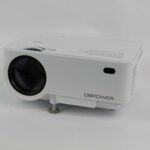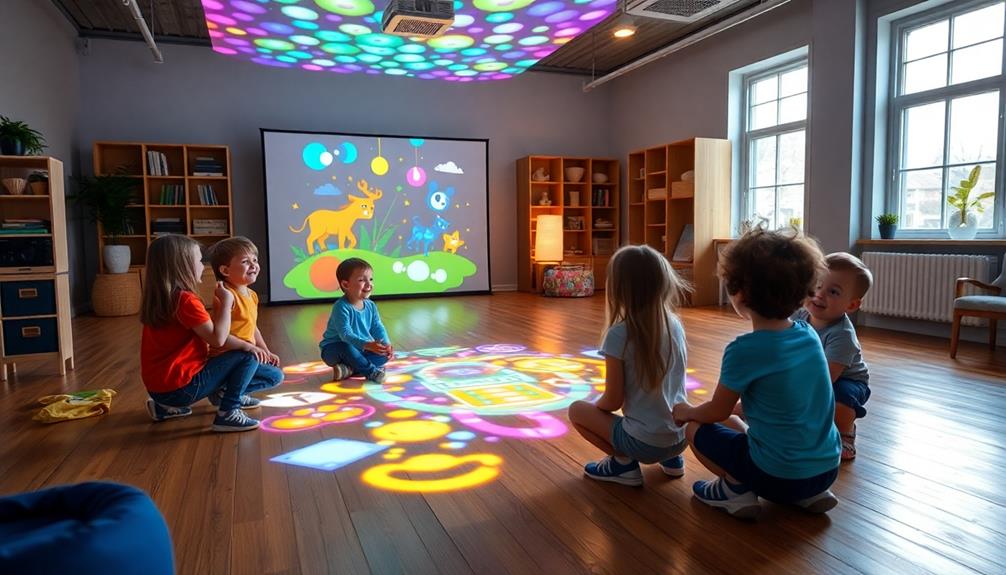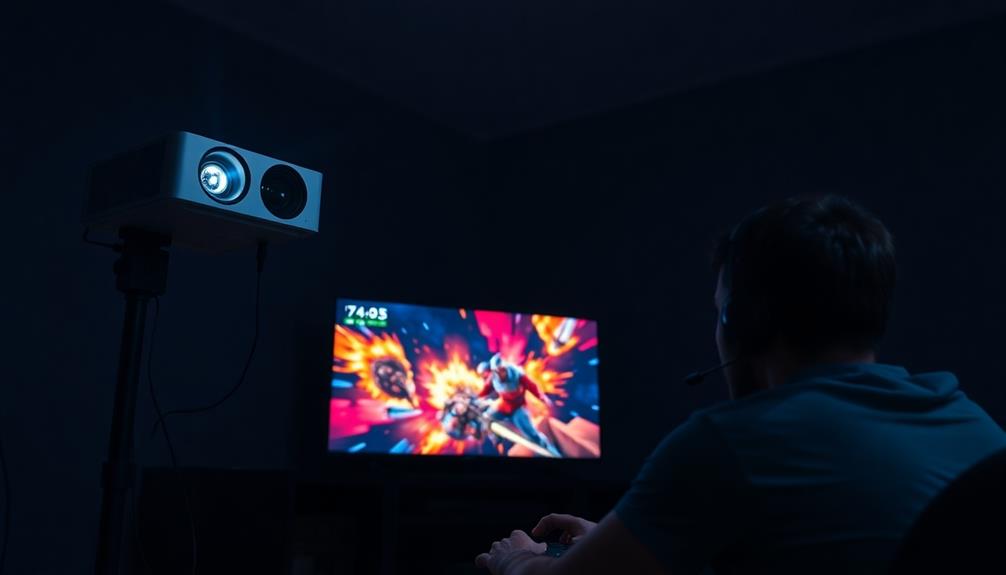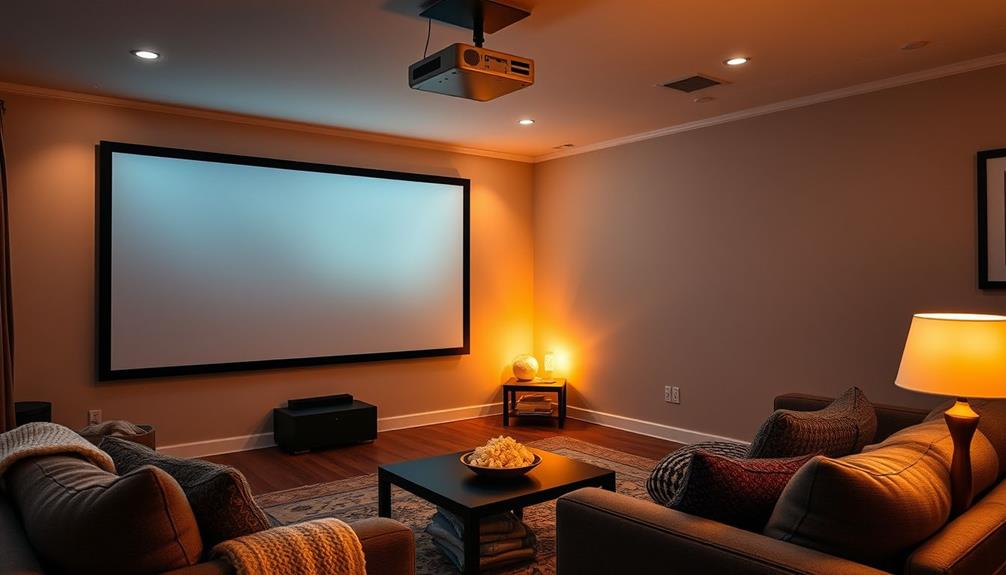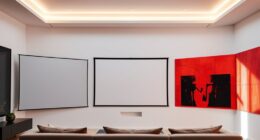To keep your projector running smoothly for years, start with regular cleaning. Use a soft, lint-free cloth to wipe the lens and remove dust with canned air. Clean the filters every 3-6 months and log maintenance dates to track lamp life. Verify proper ventilation to prevent overheating by placing it in a cool area. Handle the projector carefully, lifting it properly and allowing it to cool before moving. Finally, monitor lamp usage and consider professional servicing annually. These steps are essential for longevity, and there's even more you can do to enhance its performance effectively.
Key Takeaways
- Regularly clean the lens and filters every 3-6 months to prevent dust buildup and ensure optimal image quality.
- Maintain proper ventilation by placing the projector in a well-ventilated area to avoid overheating.
- Monitor lamp usage and replace it between 2,000 to 5,000 hours to maintain brightness and functionality.
- Schedule professional servicing every 1-2 years for thorough cleaning and to identify potential issues early.
- Store the projector in a cool, dry place with controlled temperature and humidity to prevent damage.
Regular Cleaning Techniques
To keep your projector in top shape, regular cleaning is vital. Start by using a soft, lint-free cloth to gently wipe the projector lens. Avoid direct contact to protect the film, and be sure to schedule regular cleaning sessions every few months. This prevents dust buildup on the lenses and vents, which can negatively impact performance.
Additionally, consider using a headphone extension cable to enhance sound quality and reduce interference while watching your favorite films.
Next, pay attention to the internal components. Clean the filters according to the manufacturer guidelines at least every 3-6 months. This guarantees proper airflow and prevents overheating.
Additionally, employ canned air or a small vacuum to remove dust from air vents. Unobstructed airflow is vital for effective cooling, so make this a regular part of your maintenance routine.
Always power off and unplug the projector before you start cleaning to guarantee your safety and to prevent electrical damage.
Importance of Proper Ventilation

Proper ventilation is vital for keeping your projector running smoothly and extending its lifespan. Without adequate airflow, your projector can overheat, leading to potential failures and damage to internal components.
To guarantee proper ventilation, place your projector in well-ventilated areas, avoiding enclosed spaces or proximity to walls. This allows for peak performance by facilitating heat dissipation. Additionally, maintaining a clean environment can help prevent dust accumulation, which is essential for your projector's long-term functionality, much like the importance of proper maintenance services.
Here are some maintenance tips to keep in mind for proper ventilation:
- Regularly check and clean projector fans to prevent overheating.
- Verify air intake and exhaust vents are free from dust and debris.
- Monitor the projector's operating temperature to catch performance issues early.
- Position your projector to allow sufficient space for airflow.
Careful Handling Practices

Handling your projector with care is crucial for preserving its functionality and longevity. Start by lifting the projector from the bottom using both hands; this prevents jostling and protects sensitive internal components.
Always allow the projector to cool completely before moving it, as this helps prevent thermal shock that could damage the lamp or other parts. Just like how cats show signs of separation anxiety when their owners leave, projectors can also suffer from neglect if not properly handled.
When transporting your projector, use a protective carrying case to safeguard against dust, scratches, and physical impact. This simple step is critical for maintaining performance and extending the life of your device.
Also, avoid placing the projector near high-pressure areas or heat sources, as excessive heat can degrade its performance over time.
While handling, make sure that all movements are smooth and gentle. If you need to clean the exterior, use a soft cloth to avoid scratches.
If you must access internal components, be sure to gently remove any covers and handle everything with care. By following these careful handling practices, you'll make certain your projector operates correctly and remains in excellent condition for years to come.
Managing Lamp Life

Maintaining your projector involves more than just careful handling; managing lamp life is equally important for ensuring peak performance. To extend the life of your projector lamp, follow these essential tips:
– Monitor lamp usage: Regularly check built-in indicators to know when to replace the lamp. Aim to replace it before it burns out to maintain ideal performance.
Additionally, understanding AI advancements raise considerable privacy concerns can help you consider the implications of data usage in your devices.
- Use eco mode: This setting reduces brightness and can greatly extend lamp life, typically between 2,000 to 5,000 hours.
- Avoid frequent on/off cycling: Keeping your projector on during extended use helps prevent unnecessary wear and tear on the lamp.
- Ensure proper ventilation: Place your projector in a well-ventilated area to avoid overheating, which can lead to premature lamp failure.
Always remember to turn off the projector when it's not in use to conserve lamp life.
Additionally, make sure to avoid touching the lens during cleaning to prevent damage.
Scheduling Professional Servicing

Scheduling professional servicing for your projector every 1 to 2 years is vital for maintaining its performance.
These checks can uncover hidden issues and guarantee that internal components are clean and functioning properly.
Regular servicing aligns with best practices in software quality assurance, where thorough documentation and maintenance can greatly enhance the longevity of the equipment.
Importance of Professional Servicing
Your projector's performance can greatly benefit from regular professional servicing, which should ideally be scheduled at least once a year. This proactive approach guarantees that internal components receive a thorough cleaning and can greatly enhance your projector's longevity.
Additionally, background checks, like those conducted for employees, can be essential in guaranteeing that the technicians you hire for servicing are qualified and trustworthy, ultimately protecting your investment in the equipment the importance of background checks.
Professional technicians have the expertise to identify hidden electrical connection issues, preventing potential malfunctions that could disrupt your viewing experience.
By investing in professional servicing, you can maintain peak cooling efficiency through cleaning dust buildup from internal fans and vents, which is critical for preventing overheating. This annual maintenance also extends the lifespan of the projector lamp by making sure it operates under ideal conditions and is replaced at the right time.
Here are key benefits of scheduling professional servicing:
- Thorough cleaning of internal components, enhancing performance
- Early detection of issues, saving you from costly repairs
- Improved cooling efficiency, preventing overheating
- Maximized lifespan of the projector lamp, keeping it in peak condition
Prioritizing professional servicing is a smart investment that keeps your projector running smoothly, guaranteeing you enjoy your favorite content without interruptions.
Frequency of Maintenance Checks
For ideal performance, you should aim to schedule professional servicing for your projector at least once a year. This frequency is essential for thorough cleaning and peak performance.
Regular maintenance is similar to the care needed for your pets, such as making sure they receive proper grooming and health checks like dog health and nutrition. If you're a light user, biennial servicing may suffice, but if you use your projector in high-demand environments, consider more frequent checks to guarantee reliability.
During professional servicing, experts can conduct deep cleaning of internal components that you mightn't reach during routine maintenance. They'll also inspect electrical connections, which is vital for preventing potential issues and making certain your projector operates smoothly.
To help keep track of your maintenance schedule, maintain a log of servicing dates and lamp life. This practice guarantees you don't miss timely check-ups and replacements, maximizing your projector's lifespan.
Environmental Considerations

To keep your projector in top shape, pay close attention to its storage conditions.
Just like maintaining a heat pump to prevent issues such as common issues like refrigerant leaks and compressor malfunctions, make sure your projector is stored in a cool, dry place, away from heat sources and humidity, as extreme environments can harm its internal components.
Additionally, protect it from dust and debris to maintain peak performance and longevity.
Optimal Storage Conditions
Optimal storage conditions are essential for maintaining your projector's performance and longevity. To achieve the best performance, you should keep your projector in a cool and dry storage area.
Extreme temperatures and humidity can degrade internal components over time, so make certain it's away from direct sunlight, which can cause overheating. Additionally, air purifiers improve indoor air quality by reducing allergens and dust, creating a better environment for your electronic devices.
Here are some tips for ideal storage conditions:
- Use the original shipping box or a padded carrying case to protect the projector during storage and transport.
- Position the projector upright with the lens facing up to avoid lens scratches and maintain its integrity.
- Regularly inspect the storage area to clean any dust and verify there are no environmental hazards.
- Keep the storage area organized to protect the projector from potential physical damage.
Temperature and Humidity Control
Maintaining the right temperature and humidity levels is vital for your projector's performance and longevity. Ideally, your projector should operate in environments between 50°F and 85°F (10°C to 29°C) to prevent overheating and guarantee peak performance. High humidity levels, particularly above 70%, can lead to moisture accumulation that damages internal components.
To help you manage these conditions effectively, consider the following table:
| Factor | Recommendation |
|---|---|
| Temperature | Keep between 50°F and 85°F (10°C – 29°C) |
| Humidity | Keep below 70% |
| Dehumidifier | Use if humidity is high |
| Ventilation | Guarantee adequate airflow around projector |
It's imperative to monitor and maintain the room's temperature and humidity levels regularly. Proper ventilation helps prevent stagnant air that can raise internal temperatures, leading to premature wear on components. By taking these steps, you can avoid overheating issues and greatly extend your projector's lifespan, guaranteeing it delivers exceptional performance for years to come.
Protective Measures Against Elements
Your projector's longevity hinges on how well you protect it from environmental elements. Implementing effective protective measures is essential to prevent issues like moisture damage, internal corrosion, and overheating.
Additionally, considering geothermal energy's eco-friendly benefits can inspire more sustainable practices in your home, including energy-efficient setups for your projector.
Here are some key strategies to guarantee your projector remains in top condition:
- Store it properly: Keep your projector in a cool, dry place to avoid extreme temperatures and humidity.
- Use dust-proof covers: When not in use, cover your projector with a dust-proof cover to prevent dust and debris from accumulating on the projector lamps and internal components.
- Avoid direct sunlight: Prolonged exposure to sunlight can fade colors and weaken materials, so position your projector away from windows or bright light sources.
- Maintain a temperature-controlled environment: Guarantee the room where the projector is used is climate-controlled to prevent overheating and potential failure of electronic parts.
Effective Storage Solutions

How can you guarantee your projector stays in top shape when it's not in use? To guarantee peak performance, you should store the projector in a cool, dry location away from direct sunlight. This helps prevent damage to its internal components.
When it comes to transport and storage, using the original shipping box or a foam-lined container offers maximum protection, keeping the projector upright with the lens facing up.
Before you store the projector, make sure to unplug all attached cords. This reduces wear on the connections and prevents potential electrical hazards.
After you've packed it away, cover the projector with a dust-proof bag to keep it clean and free from dust and debris.
Regularly inspect the projector for any signs of damage after transport or storage. This simple check will help you guarantee functionality before use.
Troubleshooting Common Issues

Projector problems can be frustrating, but many common issues are easy to troubleshoot. Start by checking the lamp life; if your projector displays dim images and video, it might be time for a replacement, especially if it's nearing 2,000 to 5,000 hours of use.
For colored edges on your projection, inspect the lens and perform lens cleaning with a microfiber cloth and lens cleaning solution.
If you're hearing loud noises, make certain that the air vents are clear and clean the fan to maintain peak performance and longevity. Dust particles can block airflow, damaging sensitive components inside.
To resolve missing audio, verify all cable connections are secure and confirm that the correct input source is selected.
Here are some additional troubleshooting tips to take into account:
- Check the lamp life and replace as needed.
- Clean the air vents to prevent overheating.
- Regularly perform lens cleaning to maintain image quality.
- Make certain the remote batteries are fresh and unobstructed.
Conclusion
By following these maintenance tips, you can keep your projector running smoothly for years to come. Think of it like caring for a garden; regular watering and weeding yield vibrant blooms. Just as a flower thrives with attention, your projector flourishes with routine cleanings and proper care. So, take a moment to nurture your device, and you'll be rewarded with crisp images and unforgettable movie nights. Remember, a little effort now leads to a lifetime of enjoyment!
Hello, I’m Art, and I’m excited to be a part of the 1Home Theatre Projector team. As a writer, I’m here to contribute my knowledge and insights to help you achieve the ultimate home cinema experience. I understand that making decisions in the world of home entertainment can be complex, and I’m here to simplify the process for you.







